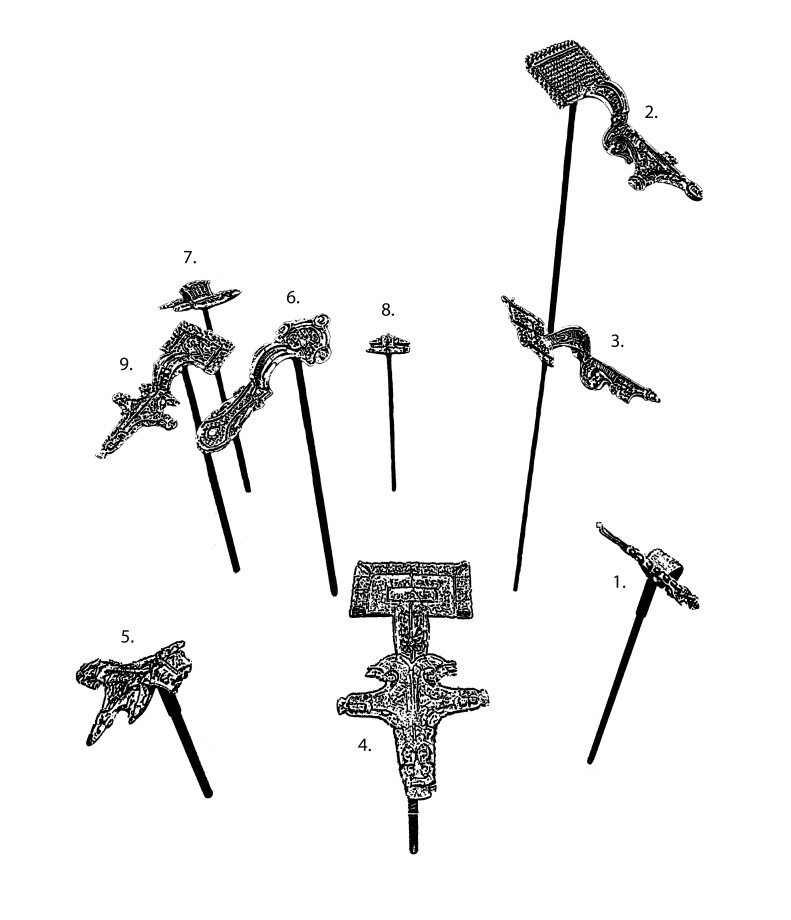From September 2023 until November 2024 you can visit the exhibition "Fabulous Animals" at Museum of Archaeology in Stavanger.
Exhibit case 7: Bearing knowledge
These large brooches from the Migration Period (c AD 400-550) are called relief brooches. They are richly decorated and we can make out both human faces and parts of animals in the ornate designs.
Some of the figures seem to be human and animal at the same time. It is not easy to understand what the figures mean. This was probably also the case in the Migration Period. The women who owned the brooches were among the chosen few who had special knowledge about the hidden animals.

In the case:
Brooches of gilt silver or copper alloy.
- Relief brooch. Hovland, Eigersund, Rogaland. S2276 a
- Relief brooch. Tveitane, Larvik, Telemark and Vestfold (Vestfold). C11221c
- Relief brooch. Bratsberg, Skien, Telemark and Vestfold (Telemark. C26566
- Relief brooch. Syre, Karmøy, rogaland. S9269 a
- Relief brooch. Skrautvål (parish), Nord-Aurdal, Innlandet (Oppland). C12280
- Relief brooch. Ommundrud, Larvik, Telemark and Vestfold (Vestfold). C29300 a
- Relief brooch. Ommundrud, Larvik, Telemark and Vestfold (Vestfold). C29300 b
- Relief brooch. Hægebostad, Lindesnes, Agder (Vest-Agder). C13697
- Relief brooch. Isesjøen, Sarpsborg, Viken (Østfold). C15668
Exhibit case 9: Journey by fire
The way people were buried tell a lot about how they thought about life, death and the Afterlife. In the Iron Age and Viking times, the dead were either buried or cremated, but cremation was most common.
Burning the body on a funeral pyre may have been a way of releasing the dead person’s spirit from the body, thus helping them on their way to the Afterlife. Burned bones from humans and animals were left behind inside the pot, whilst their souls have wandered on to the Afterlife.
In the case:
- Burned bones. Foldøy, Hjelmeland, Rogaland. S8200 d
Exhibit case 10: In the same pot
From a burial. Burned bones from cattle, pigs, dogs, horses, hares and squirrels were sometimes placed together with the cremated remains from humans.
Both animals and humans were cremated on the funeral pyre. Perhaps it was thought they would all come to life again in the Afterlife?
In cremation burials large ceramic vessels were often used as containers for bone.
In the case:
Clay pot, Espeland, Sandnes, Rogaland, S13452 a
Burned bones. Foldøy, Hjelmeland, Rogaland, S8200 d f
- Human
- Cattle
- Pig
- Bear claws
Exhibit case 16: The Bear – King of the Animals, Animal of the Kings
The bear is big, strong and dangerous. It is also the wild animal that most closely resembles humans.
It can stand on two legs, swinging its arms as it walks, and has a round head, just like us. The bear was animal of kings and chieftains – a lonely and majestic figure with enormous strength. When a bear is angry, it can ravage everything and everyone around it. The bear was the fylgia, the companion animal, of the greatest heroes. The berserks or bear warriors, were Odin’s own warriors.
The remains of real bears are sometimes found in graves from the Early Iron Age. Finds of fur and claws indicate that the dead person may have been wrapped in a bearskin.
In the case:
- Brooch decorated with a bear head at each end. The buds are shaped like small crouching bears with their front paws around their necks. Ragje, Gjesdal, Rogaland. S11240
